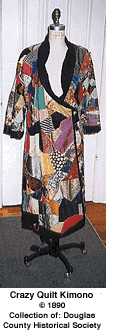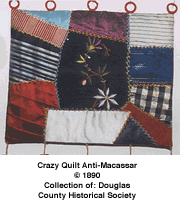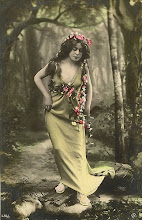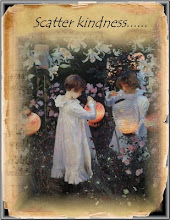Crazy quilts
Crazy Quilting as described by the Encyclopedia Britannica:
crazy quilt,
![crazy quilt [Credit: Textile Collection, National Museum of American History, Smithsonian Institution, Image #263526]](http://media-2.web.britannica.com/eb-media/33/73633-003-B6F1DCDF.gif) coverlet made by stitching irregular fabric patches together, either by appliqué or patchwork (piecing). Usually the patches are stitched to a fabric or paper foundation. Fabrics vary from cottons and wools to silks, brocades, and velvets, the latter known as “fancies.” The finished top is often enhanced with embroidery, beading, and other embellishments. Crazies are usually tied instead of quilted to stabilize the layers.
coverlet made by stitching irregular fabric patches together, either by appliqué or patchwork (piecing). Usually the patches are stitched to a fabric or paper foundation. Fabrics vary from cottons and wools to silks, brocades, and velvets, the latter known as “fancies.” The finished top is often enhanced with embroidery, beading, and other embellishments. Crazies are usually tied instead of quilted to stabilize the layers.Definition of a Crazy Quilt from Womenfolk.com:
Early quilts made in the crazy style were more show pieces than functional and were often made as smaller unquilted "lap robes" that were used to decorate the parlor. They were fitting showpieces for the lavish interior decoration of the day. These quilts were usually made using velvet, silk and brocade fabric, cut and pieced in random shapes. What a perfect way for women to show off their needlework skills! Using silk thread, women placed lovely decorative stitches on each seam. Intriguing names like feather, herringbone, fly and chain describe just a few of the intricate stitches. The imagination and skill of the seamstress was the only limit.
By Betty Pillsbury at Caron-net.com:
 Crazy Quilting, that wonderful Victorian pastime,
is enjoying an immense resurgence in popularity. However, crazy quilting is
somewhat of a misnomer. It is not quilted like a typical quilt, that is, no
quilting stitches nor batting are employed in its construction. Also, one's
mental balance does not have to be in question to crazy quilt! Rather, a crazy
quilt is a unique conglomeration of randomly pieced fancy fabrics with
embroidered embellishments on nearly every seam and patch. But it did not start
out this way. The evolution of the Crazy Quilt, as we recognize it today, is a
journey that illustrates the triumph of women's imaginativeness and ingenuity in
the face of unimaginable trials and tribulations.
Crazy Quilting, that wonderful Victorian pastime,
is enjoying an immense resurgence in popularity. However, crazy quilting is
somewhat of a misnomer. It is not quilted like a typical quilt, that is, no
quilting stitches nor batting are employed in its construction. Also, one's
mental balance does not have to be in question to crazy quilt! Rather, a crazy
quilt is a unique conglomeration of randomly pieced fancy fabrics with
embroidered embellishments on nearly every seam and patch. But it did not start
out this way. The evolution of the Crazy Quilt, as we recognize it today, is a
journey that illustrates the triumph of women's imaginativeness and ingenuity in
the face of unimaginable trials and tribulations. bedclothes wore out they were recycled. Worn
parts were cut away and any useful pieces were recombined. From these pieced
odds and ends we can readily envision how the crazy quilt came into being. It
was indeed "crazy" as far as design was concerned. There was no planned design
in shape, arrangement of color or use of materials. Similarly, as the parents'
clothes wore out, if there was a large enough area left without holes, these
pieces were used to fashion a child's dress or trousers first and only after
that was every other usable odd shaped piece left over scrupulously saved and
kept together until there was enough left for a quilt. Plaid woolens might be
sewed next to a triangle cut from red woolen underwear. As new material was
woven, scraps of "linsey-woolsey" and "shoddy" got mixed in with the precious
all-woolen material. Linen was also used and later when chintzes and calicoes
were imported from beyond the "Horn", these eventually found their way into the
quilts as well. Of course, none of these early pieced quilts have survived the
more than three centuries that have passed since they were made. Also, no one
took the time to describe them in any detail in the journals, letters and wills
which mention them. It can only be surmised from what is known of the conditions
prevailing at the time how these quilts made by the earliest colonial women must
have looked; not very pretty, because they were composed only of the stronger,
though already worn pieces of material cut from otherwise unserviceable
clothing. They were made more as result of accident borne of necessity, than
design.
bedclothes wore out they were recycled. Worn
parts were cut away and any useful pieces were recombined. From these pieced
odds and ends we can readily envision how the crazy quilt came into being. It
was indeed "crazy" as far as design was concerned. There was no planned design
in shape, arrangement of color or use of materials. Similarly, as the parents'
clothes wore out, if there was a large enough area left without holes, these
pieces were used to fashion a child's dress or trousers first and only after
that was every other usable odd shaped piece left over scrupulously saved and
kept together until there was enough left for a quilt. Plaid woolens might be
sewed next to a triangle cut from red woolen underwear. As new material was
woven, scraps of "linsey-woolsey" and "shoddy" got mixed in with the precious
all-woolen material. Linen was also used and later when chintzes and calicoes
were imported from beyond the "Horn", these eventually found their way into the
quilts as well. Of course, none of these early pieced quilts have survived the
more than three centuries that have passed since they were made. Also, no one
took the time to describe them in any detail in the journals, letters and wills
which mention them. It can only be surmised from what is known of the conditions
prevailing at the time how these quilts made by the earliest colonial women must
have looked; not very pretty, because they were composed only of the stronger,
though already worn pieces of material cut from otherwise unserviceable
clothing. They were made more as result of accident borne of necessity, than
design. There were two ways to make a crazy quilt. In the
first, each tiny piece was fitted together with others like a jigsaw puzzle and
pieces were just as irregular in shape. Sometimes if a piece was too large, it
was cut into smaller ones to maintain a sort of average of dimension in a
general area. This was the beginning of the organization of design. The second
type of crazy quilt was made at a later date and in it were put scraps of silk,
velvet, brocade, plush satin, wool, cotton and linen. Bits of a wedding dress
might be sewed next to a remnant from a scarlet uniform. These quilts were for
the most part made in blocks (the square units of design that make up a quilt).
The designer determined the size of the quilt and then decided just how many
blocks she wished to put into her "top". When the maker of this type of quilt
decided on the size of her block, she proceeded to baste her irregular pieces
upon it. These background blocks were usually made of coarsely woven
sackcloth.
There were two ways to make a crazy quilt. In the
first, each tiny piece was fitted together with others like a jigsaw puzzle and
pieces were just as irregular in shape. Sometimes if a piece was too large, it
was cut into smaller ones to maintain a sort of average of dimension in a
general area. This was the beginning of the organization of design. The second
type of crazy quilt was made at a later date and in it were put scraps of silk,
velvet, brocade, plush satin, wool, cotton and linen. Bits of a wedding dress
might be sewed next to a remnant from a scarlet uniform. These quilts were for
the most part made in blocks (the square units of design that make up a quilt).
The designer determined the size of the quilt and then decided just how many
blocks she wished to put into her "top". When the maker of this type of quilt
decided on the size of her block, she proceeded to baste her irregular pieces
upon it. These background blocks were usually made of coarsely woven
sackcloth.
































1 comment:
So true! It is so nice to have the vintage CQ's for our inspiration as we add our own bit to make them our own.My definition~ freedom to play with fabric, thread, color and embellishments.
Post a Comment